Last year, Victoria author Marianne Scott published The Distilleries of Vancouver Island—a Guided Tour of West Coast Craft and Artisan Spirits. Here she writes about some of those distilleries that are based in breweries in the Greater Victoria area.

Macaloney’s Caledonian Distillery and Twa Dogs Brewery
“Whisky is basically beer—without the hops—and distilled at least twice.”
That’s what Graeme Macaloney told me during my visit to the Caledonian Distillery and Twa Dogs Brewery on the outskirts of Victoria. “People are often surprised to learn that a distillery is essentially a brewery with two copper pot stills attached at the end,” he continued. “And for Caledonia, the combination of brewery and distillery allows us to develop cross-over products.”
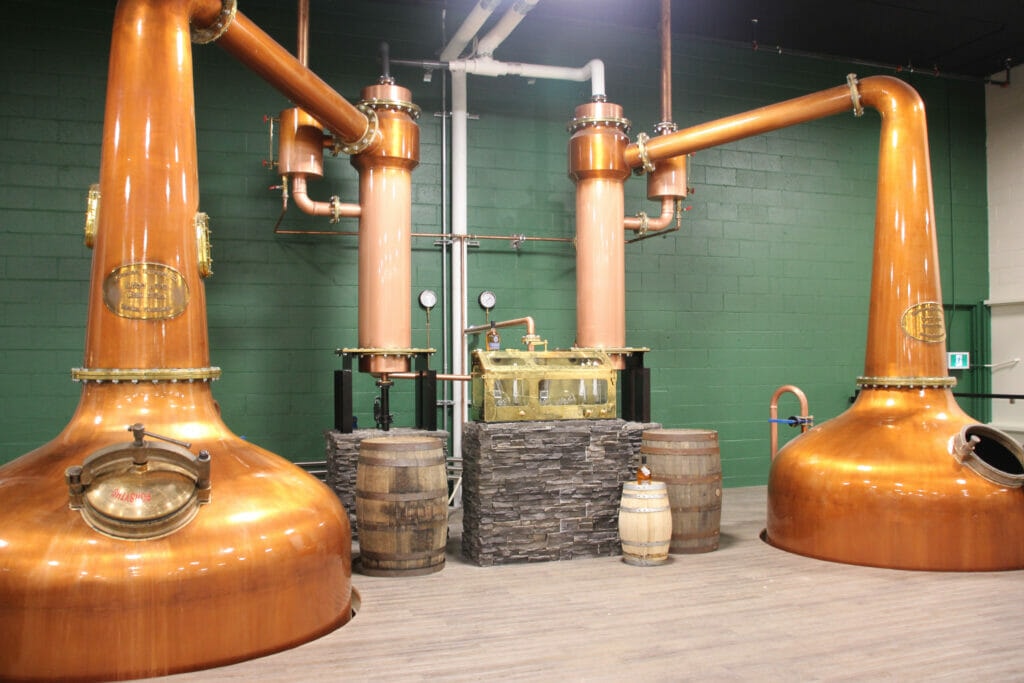
As I strolled around his roomy brewing/distilling/bottling building, I sniffed the heady, yeasty scent of fermenting grain. It gave me a homey feeling and triggered my anticipation of the delicious drinks to come. In the impressive 17,000-square-foot space, it became clear that beer and spirits are family: a row of stainless mash tuns line one side of the space—the mother of both the beer and spirits Caledonian produces. The other side is home to a platform supporting twin copper stills resembling gigantic Hershey kisses. I felt dwarfed by their 4.8-metre height—they hold 5,500 litres and 3,600 litres respectively. They’re manufactured by Forsyths, a Scottish company that began building its hand-made stills in 1895.

It’s not an overstatement to say that for Macaloney, creating beverages containing alcohol is bred in the bone. He’s the genuine article, born in the village of Gartcosh, Scotland, a few miles east of Glasgow in North Lanarkshire, a part of the world where the art of whisky making is legendary. Whenever we’ve met, he’s worn his ancestral Cameron tartan kilt complete with sporran and white knee socks. His Scottish brogue evokes visions of heather, thistle and bagpipes.
“As a student, I had a summer job at the Black and White Scotch distillery and I fell in love with Uisge Beatha, Gaelic for ‘water of life,’” he said. “I’ve always had the idea that someday, I’d have a distillery of my own.”
Graeme has certainly succeeded in that goal. But getting there took education and experience. He studied microbiology at Glasgow’s University of Strathclyde, followed by a master’s degree in biochemical engineering at University College, London. He returned to Strathclyde for a Ph.D. in microbiology or, as he said with a chuckle, “fermentation.”
He then worked in the antibiotics divisions of Pfizer and Eli Lilly. “Some people don’t realize that antibiotic production depends on a heavy dose of fermentation technology, similar to that of beer brewing and liquor production,” he explained.
In 1989, Graeme emigrated to Canada having found a job at the Alberta Research Council’s pilot fermentation plant. He also discovered the joys of Canada’s outdoors and judged the quality of life to be better than that in the UK.
“While at the Research Council, I learned about start-ups using our services,” he said. “Many had found innovative ways to fund their enterprises with equity financing and angel investors. I knew that a start-up distillery needed major investment but would have low revenues while the alcohol matures.”
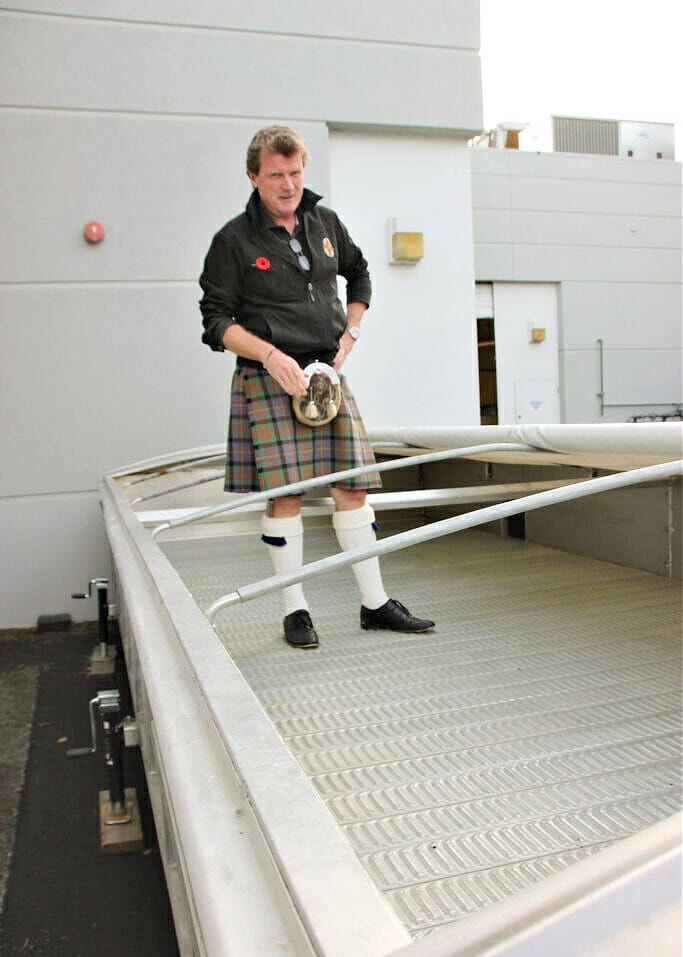
That’s how Twa Dogs Brewery was born (among other inventive ways of raising funds). The brewery is named after the long poem by famous Scottish poet Robert (Robbie) Burns, whose writings—and birthday—are celebrated around the world. In comparison to whisky, which takes at least three years to mature (often more), beer can be produced quickly and offers much-needed cash flow while the spirits sleep and mature in their casks.
Caledonian has created a group of unfiltered specialty beers that have attracted a faithful following and steady income. Graeme continues to invent catchy names for the craft beers, all with a whiff of humour, including such monikers as Life and Liberty Pale Ale, Lavender Saison, Keekin’ Glass Pilsner, Mistress of My Soul, and Parting Kiss Bourbon Barrel Ale.
Graeme built a large smoker that burns peat from the Olympic Peninsula—a regional “terroir”—and toasts tons of barley placed inside to be used in the peated whisky they produce, as well as in some special “smoky” beers. Peat smoke produces chemicals called phenols which are absorbed by malted barley.
Graeme handed me two glasses filled with tawny-coloured grain grown in BC. “This one is regular malted and dried barley,” he pointed. “You can see the little sprouts when the barley germinated. But the other glass contains barley that’s been bathed in peat smoke. It’s popcorn for peat heads.”
I sniffed and tasted a few kernels from the first glass. It was crunchy. “I think this would fit well into my homemade granola,” I said. The second grain is equally crispy, but its scent and taste led me to fantasize I was visiting Islay or Orkney, two of the Scottish islands where peated whisky is produced. Some have called it “campfire in a glass.”
Several of Caledonian’s whiskies have now matured and are winning international, prestigious prizes. They’re an excellent complement to the company’s innovative craft beers—a match seemingly made in heaven.

Moon Under Water Brewery, Pub & Distillery
Clay Potter, who brews beer and distils spirits at the Moon Under Water Brewery, Pub & Distillery in Victoria, learned to appreciate beer early in his young life. Every Friday night, his mom, Anne Farmer-Ash, brought home a six pack—each a different European brand and flavour. Mother and son would share a beer taste test. Meanwhile, Clay’s stepfather, Steve Ash, operated a metal shop next door to Phillips Brewing when that firm first launched in Esquimalt. He got to know owner Matt Phillips (more on Matt later) and watched the company grow from a tiny craft brewery to the prime craft beer producer in British Columbia. “We loved their beers,” said Clay. “And my stepdad was there when welding and other metalwork was needed.”
Clay never intended to become a beer producer. Like Graeme, he studied microbiology at university and he thought medical school was in his future. Beer intervened. During a co-op work term, he began working at Lighthouse Brewery in Esquimalt.
“I set up a testing lab for them,” Clay said. “Then the brewmaster left to set up his own company. So another young guy, Dan Murphy, and I were both promoted to brewer. We had home-brewed together in the past so we were the only two people there with any experience. Naturally, we had to scale up. I was only 20 but worked full time. Heady days. It took a while but I eventually also earned my UVic microbiology degree.”
Clay grew ever more enamoured of the brewing process. “I fell in love with the industry,” he said. He spent more than three years at Lighthouse fermenting, brewing, filtering and packaging. And he also got involved in the technical side of brewing, the type of processes the happy-hour beer consumer might not think about. He set up a quality control lab and also developed a yeast management system that optimizes the concentration and oxygenation rates for different types of yeast strains. It seems to me that all his microbiology studies had an applied effect.
Despite these brewing experiences, he wanted more education specifically devoted to the art and science of brewing and distilling. Where could he go? Scotland, of course. He enrolled at Heriot-Watt University in Edinburgh.
After completing his studies at Heriot-Watt University, Clay returned to Canada. But what was he going to do with his further education in alcohol processing? Luckily, a friend spotted an advertisement: the Moon Under Water Brewery and Taphouse in downtown Victoria was for sale. “To finance the operation, my mom, stepfather and I pooled our resources,” Clay recalled. “We all maxed out our credit cards, investing every last penny we could lay our hands on.”
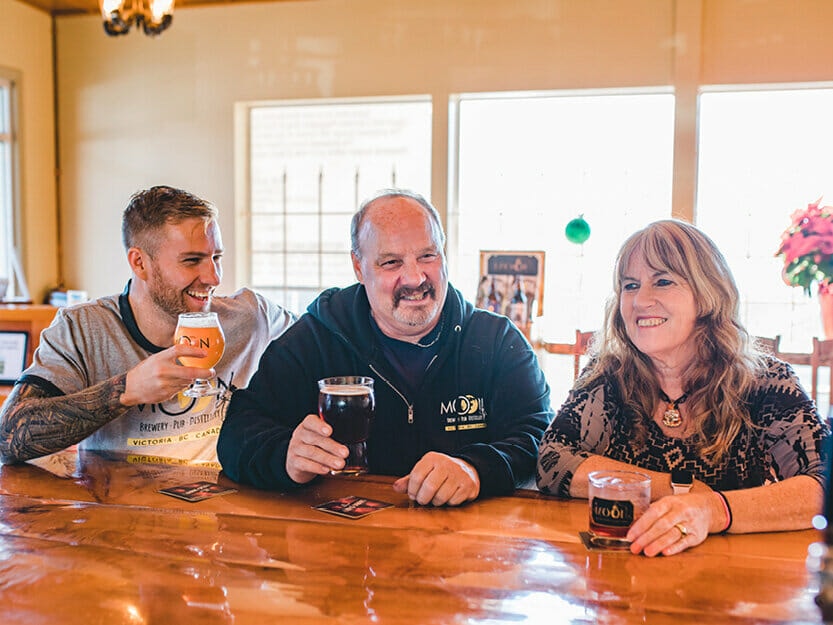
Today, the three co-owners each have their niche. Anne runs the office, manages the finances and oversees the restaurant; Clay and his crew brew beer and distil spirits; and Steve ensures all the equipment works, while also pitching in whenever needed.
The family trio kept the Moon name, refurbished the pub, and focused on brewing German-style beers, continually inventing new flavours. The brewpub flourished, but after being in business for about five years, growth slowed. “We had a lot more craft breweries in BC but the pie wasn’t getting bigger,” Clay noted. “The ready-to-drink market was also expanding and cut into the craft beer market.” So he dusted off his Edinburgh distilling credentials and started looking for a commercial still to supplement the brewery, especially as he and Steve had already been experimenting with distilling small batches of rye, whisky and rum in a 30-litre, all-copper still.
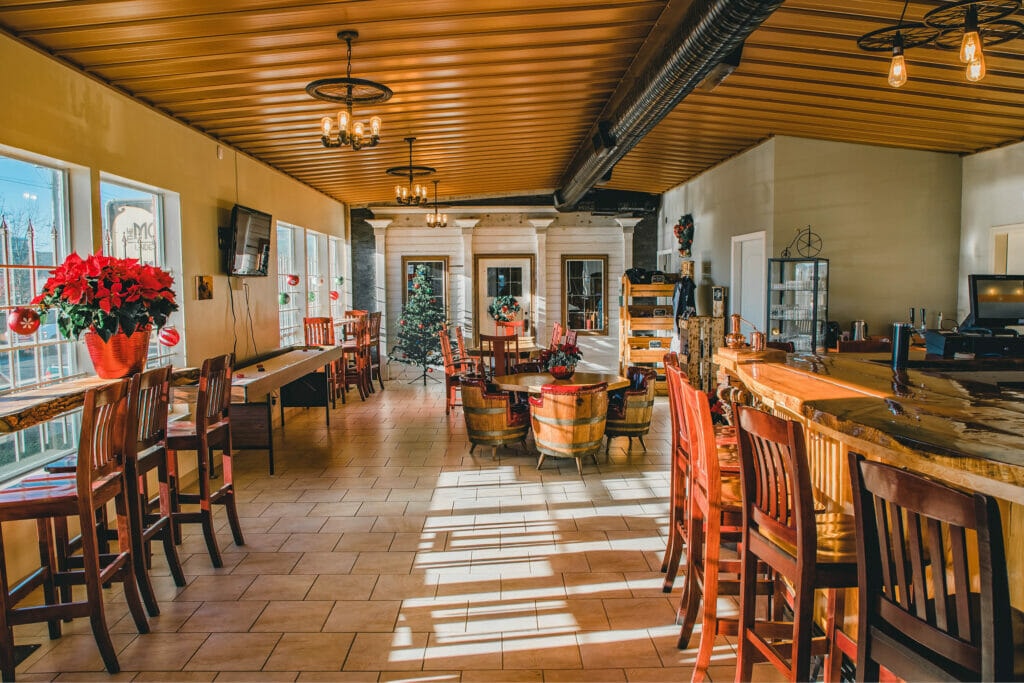
A space next to the brewery became available, allowing room for a still and a tasting room complete with bar and barrel-shaped chairs. Clay bought a larger still, a 500-litre Genio still manufactured in Sieluń, Poland. It looks different from most stills—it has a black insulating outside cover—and the pot’s interior is lined with stainless steel.
“It’s designed for vodka,” said Clay, “but it can bypass the plates to make whisky. I can add a gin column two feet tall that I fill with copper coils. That’s the copper contact needed to make whisky. I bought this adaptable still because it was much less expensive.”
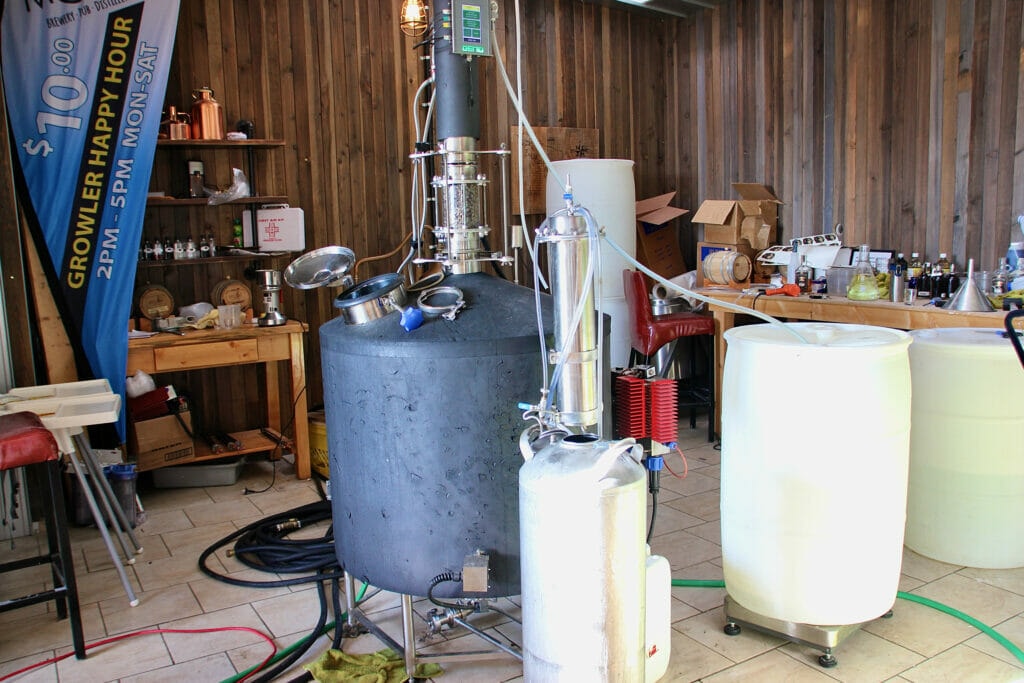
Clay started distilling his Scottish-inspired whisky using 100% Vancouver Island-grown malted barley, supplied by Phillips Brewing and Malting, located just a few kilometres from the Moon. Proving Graeme Macaloney’s statement that beer and spirits come from the same source, Moon’s malted barley is mashed in mash tuns, and the wash is distilled through the Genio still, its column packed with copper coils to give it the required copper contact.
Over time, Clay acquired 60 diverse casks that once held bourbon, Burgundy, Bordeaux and port. His whiskies are maturing in these casks tucked away in the brewery’s nooks. Some of the casks were previously used to contain fruited and sour beers; they’re now doing double—even triple—duty in the distillery.
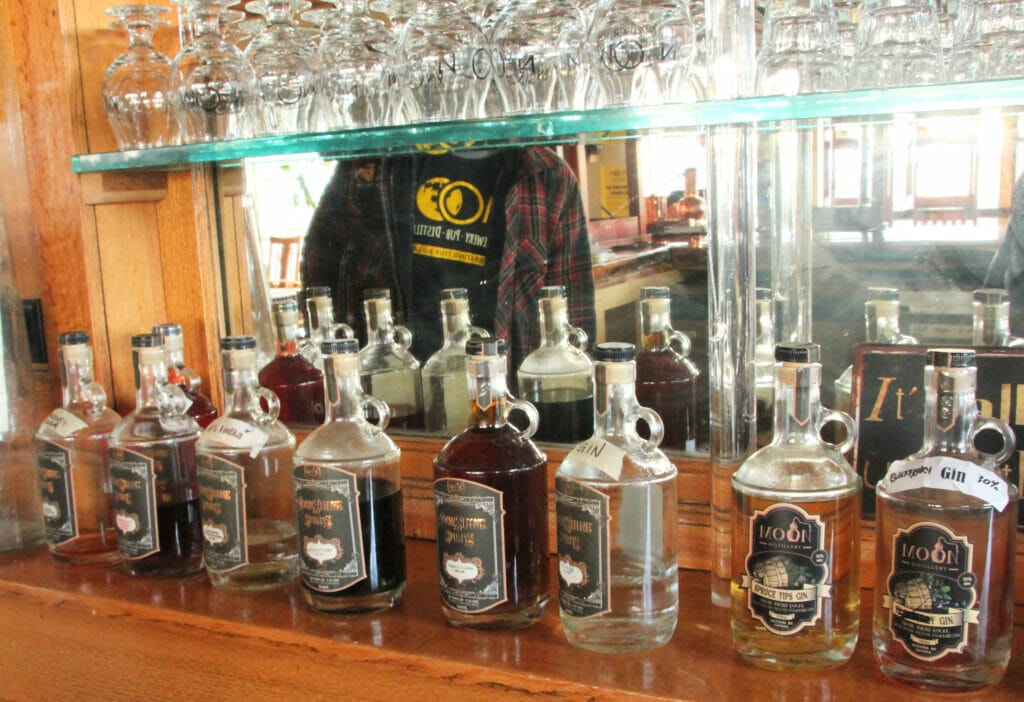
The Moon’s restaurant offers food and its craft beers, of course, and its distillery lounge focuses on the many elixirs Clay distills and flavours. Taking advantage of Victoria’s blossoming cocktail culture, Clay created a fleet of flavoured vodkas and gins. He told me that gin has seen a revival and has become a best seller at the various farmer and craft markets. “It’s now the ‘in’ cocktail spirit,” he said. “Our bartender and I are continuously experimenting with new cocktail recipes.”
Moon’s flavoured gin infusions are on the cocktail menu, including Blueberry Gin, Citrus Gin—flavoured with orange, lemon, lime, and grapefruit peel—as well as Spruce Tips Gin.
One of the Moon tasting room’s advantages is that customers can order from the full pub bill-of-fare located right next door. Pairing food with cocktails is a capital idea for people who must drive home after their evening out. “Our premises now do triple duty,” said Clay. “The brewery’s beers, the distillery’s spirits and the restaurant’s food all work together.”
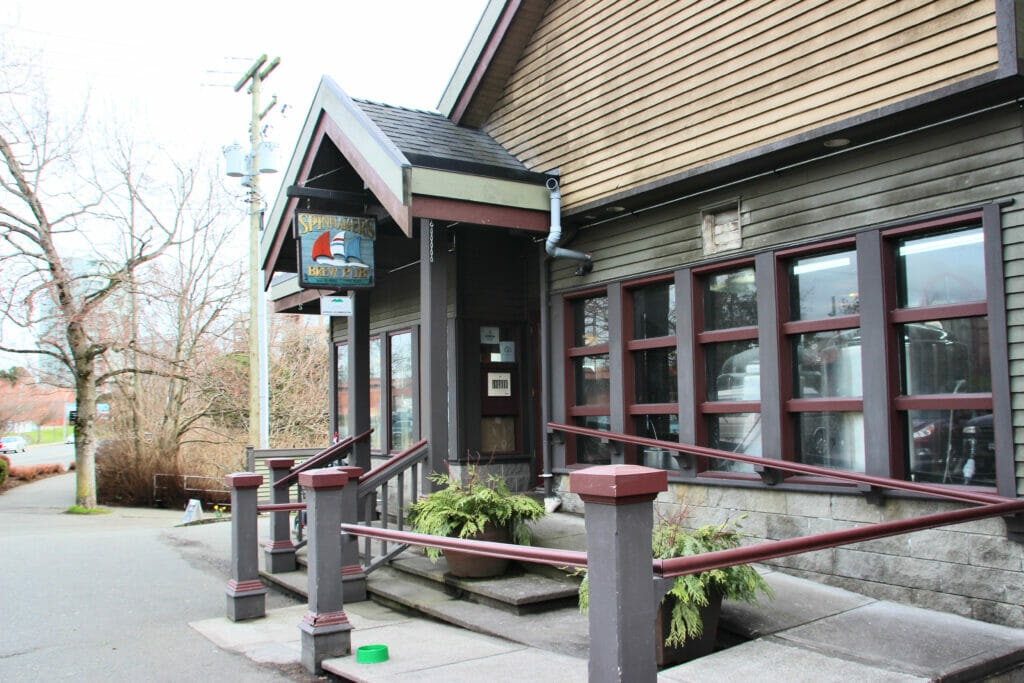
Spinnakers Brewpub
In 1984, Paul Hadfield founded the purpose-built Spinnakers Gastro Brewpub, the beginning of a brewpub revolution, allowing beer brewed on the premises to be sold in a pub or restaurant at the same location.
Spinnakers is located on the Victoria Harbour in Vic West, where the view and the excellent beer and restaurant fare has turned it into a popular destination.
The brewery focuses on its craft classic ales, specialty beers, and on barrel-aged and sour beers. Some examples include Bourbon Black Lager, which is infused with bourbon-soaked oak chips, while Scottish Ale has a malty taste with just a hint of peat. Spinnakers also uses oak barrels that once contained red and white wines, whisky, rye whisky, bourbon and tequila to flavour their beers. They’re called “slow beers” as they take time to mature.
Like so many breweries and distilleries on Vancouver Island, Spinnakers is a family affair. One of Paul’s daughters, Carly Hadfield, learned about beer making at home as a kid and after growing up, she and her partner Troy Pyett moved to Castlegar where they own the Lion’s Head Pub. The other daughter, Kala, stayed home and also cut her teeth on brewing. When Spinnakers opened, Kala was just learning to crawl, and during her growing years Kala was exposed to the business of making beer and serving food. She served as one of Spinnakers’ bartenders for a decade, dispensing beer in the taproom and mixing cocktails.
Kala moved from serving beer to brewing after one of the brewers left. She already knew she preferred production over working the front of house. “In 2010, I started on the packaging line and making deliveries,” she said. Over the next decade, she moved up through cellaring, brewing and cider making to a management position. “I’ve been a ‘brew-collar worker,’” she quipped.
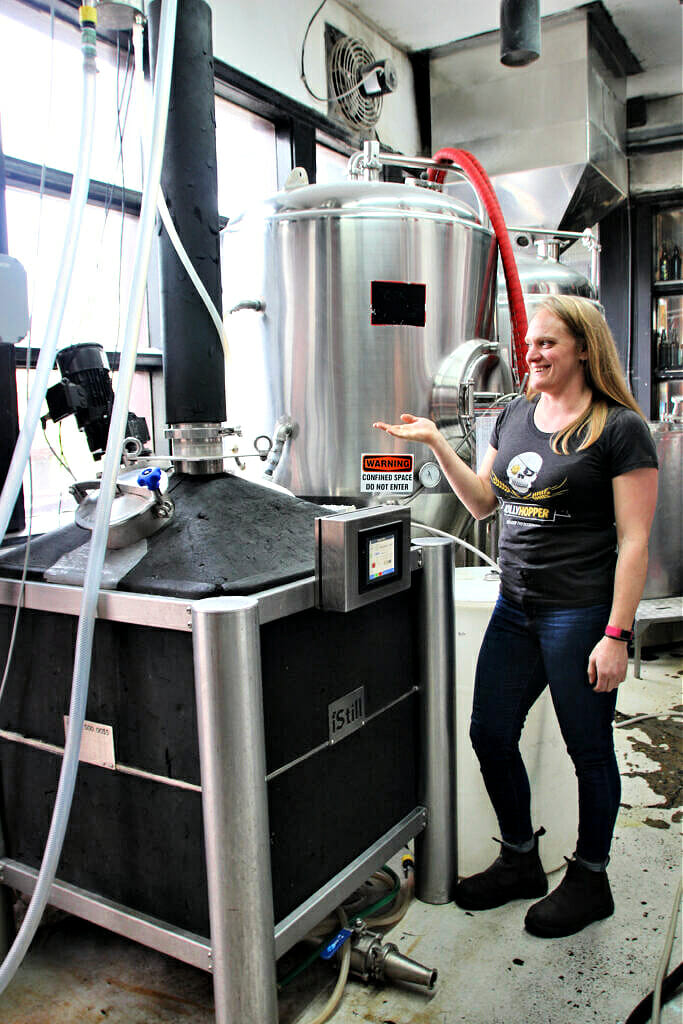
Along the way, Spinnakers decided to launch a distillery with Kala as its head distiller. The company bought a still manufactured by iStill, a firm located in the Netherlands. The stills they produce look different from traditional glossy ones: they’re square and insulated with black foam. The iStill website claims they are 21st century manufacturers, whose square shaped-stills are easier to fit into distilleries, with lower electrical demands, and electronic systems that help craft distillers become more efficient.
“Being powered by electricity was a big deciding factor in choosing the iStill [since our brewery is also electric] and the fact that the small footprint of the still fits well in our condensed space,” Kala commented.
As part of her distilling training, Kala signed up for a course with iStill, held in Napa Valley, California. “It was a week-long course, very hands-on,” she said. “It included the theory of distilling too. But after the courses you have to learn the actual process yourself. It’s an intense experience.” She added that although presently she is the only distiller at Spinnakers, she is part of the team of brewers who provide the beer wash she uses as the base for distilling spirits—again echoing Graeme Macaloney’s views on the marriage of beer and liquor.
“I already had a good background in making mashes and fermenting,” Kala said. “The challenge lay in learning to use the equipment that gives rise to our smooth vodka. I did a lot of experimenting and re-distilling. Of course, in comparison with beer, it takes vastly more volume passing through a still to produce just one litre of vodka or gin.”
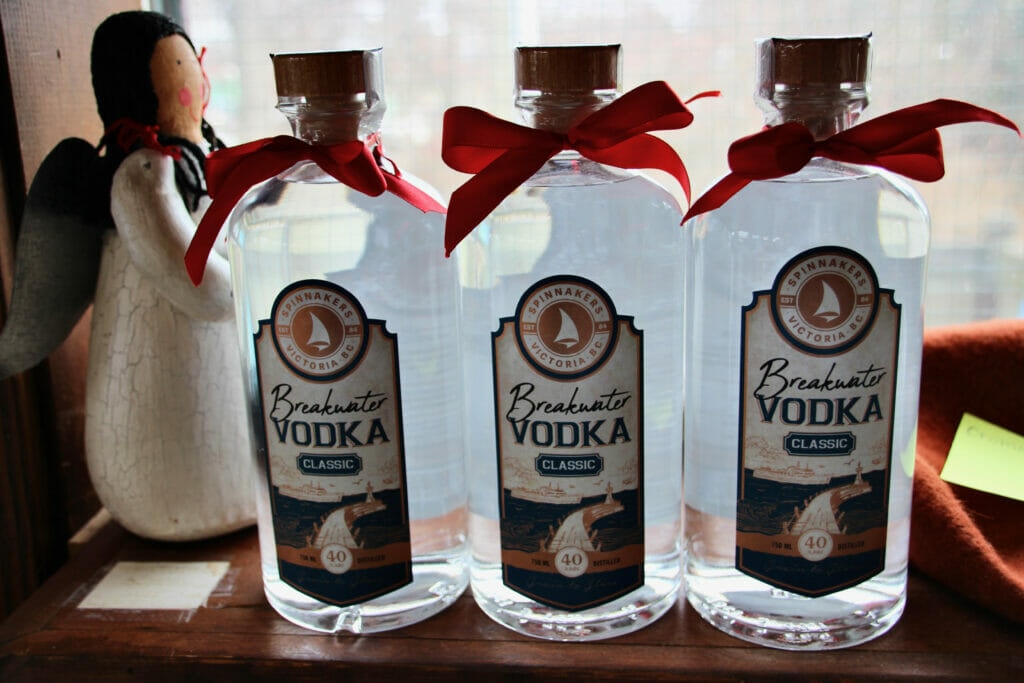
After Kala imports Spinnakers malted-barley craft beer wash into her still, she runs it four times to create the low wine she needs for one spirit run. She then distills it two more times for the Breakwater Classic Vodka and a third time to make the Botanical Beach Gins to reach at least 95% alcohol purity. When diluted, the vodka’s alcohol by volume is 40%. Two versions of gin are on offer: a London Dry type with an alcohol by volume of 43% and a “Navy Strength” style with a whopping 57% alcohol by volume. Sipping it made me feel my chest was on fire. She also created some new tipples including Au Currant Crème de Cassis, Chocoholic Crème de Cacao, Cranberry Gin and Strawberry Gin.
Now that she has produced many batches of spirits, Kala is happy to have added distilling to her reservoir of talents. “It’s fun,” she said. “I love learning new skills. It’s a challenge and it’s creative.”
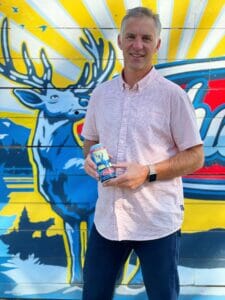
Phillips Brewing and Malting Co. and Fermentorium
Brewer/distiller Matt Phillips started his career as a brewmaster and has based many of his brewing and distilling talents on his Mount Allison University’s degree in microbiology. It seems like microbiology is a prerequisite for becoming a brewer/distiller. “It’s a great base,” he said. “For example, it helps my knowledge of brewer’s yeast. I know that when the yeast is happy, I’m happy.”
The road to success for this entrepreneur was built on tenacity, risk taking and the willingness to live without comfort—at least for a while. Wanting to perfect his knowledge of the art and science of beer brewing, he came west: BC was the place for craft brewing. He worked at Whistler Brewing and Spinnakers, and then decided to open his own place.
In 2001, Phillips opened his first 1,300-square-foot brewery in Esquimalt, on the second floor of an industrial building. Lacking cash flow, he bedded down (illegally) at the brewery for two years; fortunately, he could shower at a nearby gym. It was a completely do-it-yourself enterprise. He brewed the beer, bottled, labelled, packaged and delivered it to various liquor stores in a rented U-Haul truck. His beers were bold and unorthodox, especially for the times: Espresso stout, raspberry wheat ale and a boldly-hopped IPA.
With growing success, Phillips moved twice, eventually settling into much larger premises on Government Street in 2008. Always looking to experiment, Matt had obtained a distilling licence while still in Esquimalt.

Matt chose the name “Fermentorium” for the distillery (a Phillips Distillery already existed in Minnesota). Along the way, he’d obtained a huge old pot still. No one knows for sure when it was constructed—I’ve been told a variety of dates, but most agree it’s at least 90 years of age. It’s part of the copper still’s mystery and mystique.
It was nicknamed “Old George” and was moved in pieces to its new premises, where it languished. “We lacked the manpower to set up the old still,” said Matt. Beer sales were so successful that distilling was put on the back burner. “It was after the government asked why we weren’t using the still and threatened to revoke our licence that we went back to the idea of distilling.”
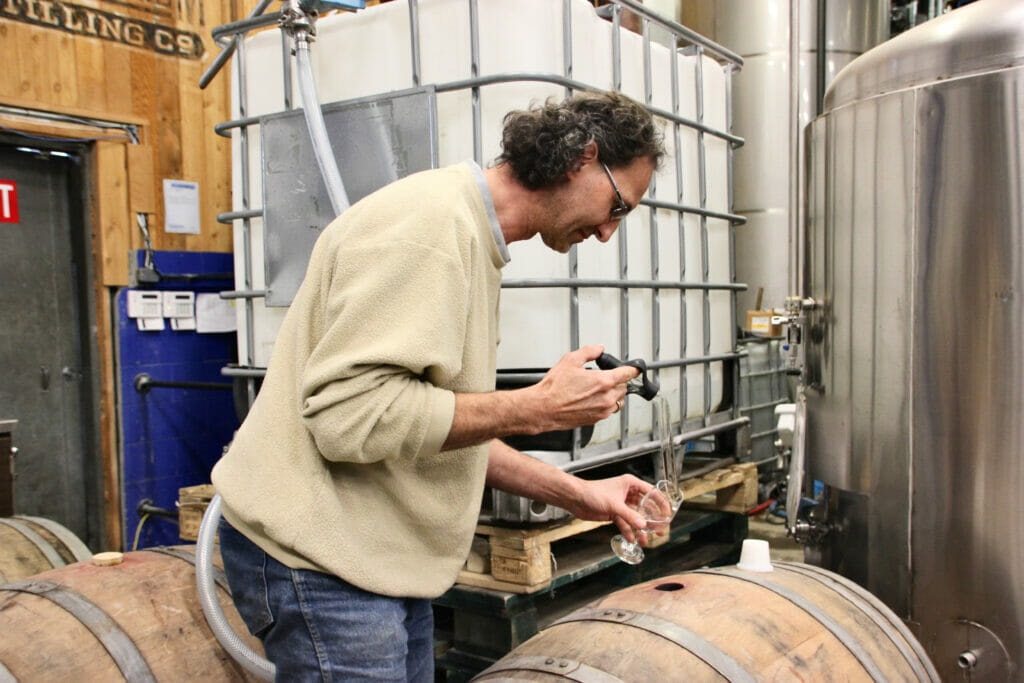
To begin the distilling process, Phillips obtained the services of master distiller Laurent LaFuente, who learned wine-making in Switzerland and subsequently specialized in distilling. Of French origin, Laurent sees poetry in local distilling. “Making spirits is creative,” he told me. “What I want to reach is ‘creativity in a bottle.’ When you drink craft spirits with friends, you know it’s a special occasion. And when you buy a bottle of craft, you buy a piece of the soul of the people who created it. It brings little bits of happiness. Part of the spirit is the connection to the place we live. It’s spiritual. We need roots. When we buy local, we’re rooted.”
Laurent consults with many distilleries—both start-ups and mature ones. He started the processing of Phillips’ gins and whiskies in 2014.
Matt is highly pleased with having launched the distillery. “It’s been a blast,” he said. “The brewery is very busy and that gives us patience to wait for spirit maturity. It’s not a stretch to distill. It’s fun, challenging and a good add-on. We have the equipment that can cross over to some degree. We don’t need to sell liquor for cash flow so we can take our time.”
The whiskies are being stored in casks previously containing bourbon, beer or pinot noir. “We crank out 250-300 barrels a year,” Matt continued. “Once mature, these whiskies are barrel blended. Blending is a whole separate art. For the gin, every batch is slightly different. We mature it in barrels too. It’s an art, a fun art, for both the nose and the mouth.”

The barley the Fermentorium uses is grown on the Saanich Peninsula and the rest of Vancouver Island. Phillips added its own malting plant in 2015—the colossal towers are located behind the brewing/distilling building. Malting is the process when grains germinate or sprout in water. The wetted grain is then dried and when put in a mash tun produces the needed enzymes and sugars for brewing and distilling.
“People don’t often realize that barley must be malted before you can use it in making alcoholic beverages,” Matt said. “We’re now one of only three or four craft breweries/distilleries in North America with its own malting plant.”
One of the people who worked—and trained—with Laurent LaFuente is Damon Bell, now Phillips’ main distiller. “We added a made-in-Germany Mueller Brennerei pot still in 2014,” he told me.
Wearing a baseball cap and plaid shirt and sporting a trimmed black beard, Damon hails from Manitoba. “I learned distilling on the job,” he said. “I got pointers from Laurent LaFuente. He’s very European, very romantic about distilling, very hands-on. I also read ‘endless’ treatises on the theory of distilling, but for me, having a mentor, someone with great distilling experience, is much better than going to school in Scotland.”
Coastal Forest Stump Gin is Phillips’ flagship spirit. It’s strongly flavoured with locally foraged juniper, hops, bay laurel, coriander, lavender, fennel, and to make the tang ever pinier, grand fir tips. According to Laurent, “drinking Stump is like walking through a coastal forest.”
“We wanted Stump to be very distinctive,” said Damon. “To be very Vancouver Island. The grand fir is foraged for us in the region by a First Nations specialist. He collects a couple of times a year and chooses mature branches with the firm flavour of mature leaves.”
Small Talk Whisky has had two releases and more is maturing in casks. “It’s based,” said Damon, “on the unique characteristics of Saanich Peninsula barley.”
Phillips has a tasting room that serves 16 craft beers on tap as well as its spirits. The tasting room’s large indoor windows allow patrons to see the bottling area and get a glimpse of an active working brewery.

Driftwood Brewery and Distillery
The latest brewery to add a distillery to its beer production is Driftwood, a brewery that first opened its doors in 2008 in just 3,500 sq.ft. of space in Rock Bay. In the early days, the trio of owners did it all—brewing, bottling and packaging. As the company grew, it ran its operations in several smaller warehouses, but it recently acquired a 58,000 square-foot facility in Esquimalt. It’s the first time in years that brewing, distilling, bottling and packaging are being managed in a single space, making operations vastly more efficient. Driftwood also built an inviting taproom on the premises, with a bar, tables and some beautiful murals depicting orcas, sea creatures and floating kelp. It has a nice vibe.
Driftwood continues to be owned by the three founders, Gary Lindsay (marketing), Kevin Hearsum (Commanding Officer of Gettin’r Done) and Jason Myer (Wizard of Wort). I had a chance to speak with both Gary and Jason.
“We all worked at Lighthouse Brewing in Esquimalt,” Gary told me. “Our shared experience led us to decide to form our own brewery, to brew new versions of beer. Basically, to brew the beer we like ourselves. “
Driftwood gets its malt from Alberta, and some smaller amounts of grain from Germany and the UK. “We use the European malts for flavour,” said Gary, “and to brew our specialty beers. That said, for each recipe, everything twists toward the west coast, to our own interpretations of how to use water and the ingredients. What distinguishes us is our strong dedication to quality, not gimmickry.”
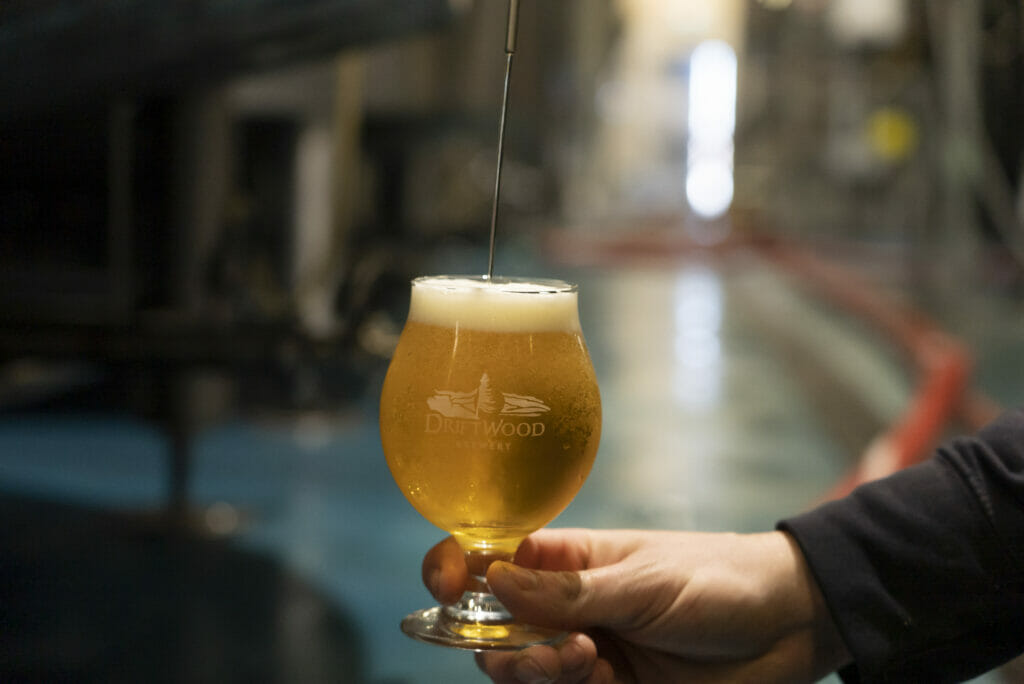
Gary states that a single beer, Fat Tug IPA, represents 60% of Driftwood’s total sales. “In addition, we have 12 core beers that are always available. We stick to what we like. We want consistency. But beer consumers can be fickle. They’re not necessarily committed to one beer type. So we always introduce specialty beers, like Mad Bruin and Limb from Limb.”
Co-owner Jason Meyer began his home-brewing adventures at age 19 while at university and, he said, “it became a real passion for me.” He ended up going to Edmonton and working in a brewery. A stint in Scotland followed, which led him to experiment with spirit distilling at home, even though it wasn’t legal.
One of his deep interests is yeast. “I take a hands-on approach to fermentation,” he explained. “You have to control the yeast to get a good beer. There are dozens of strains of yeast and you must choose the right one for the project. I concentrate on producing big, bold beers.”
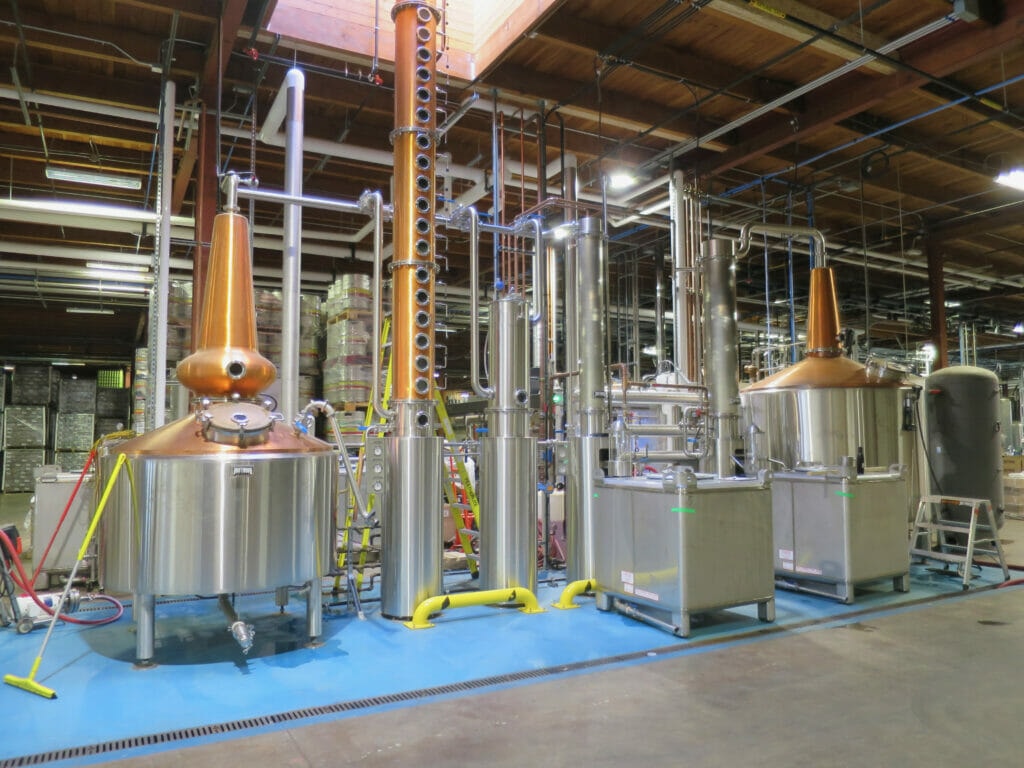
Driftwood had long thought of opening a distillery, but with its multiple production locations, it just wasn’t feasible. Once the spacious new warehouse was obtained, they hired Brendan Cook to make their first spirits. They also acquired two stills made locally by Specific Mechanical Systems and installed them in their new space, building a small “cupola” in the roof to house the tall still’s column.
Brendan gained experience in distilling after deciding to forego law school. He liked brewing and distilling so went to Glasgow to learn more, ending up working at three of the Scotch distilleries owned by spirit conglomerate Brown-Forman. His work experience led to him becoming a master blender. He came to Driftwood 1.5 years ago, just in time to put his distilling talents to the test.
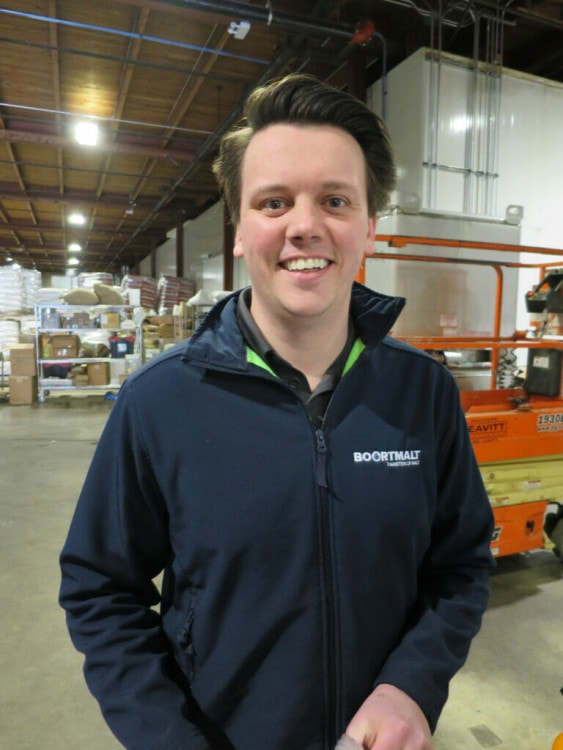
Naming their signature gin “Contact,” Brendan explains this gin features west coast flavours, and includes such botanicals as juniper, orange, grapefruit and beeswax (!) and some other ingredients Brendan wishes to keep secret. These botanicals are macerated in a gin basket. “Our Contact gin creates the illusion of sweetness,” he says. “Parabola is the second gin we’ve distilled, which has more floral notes like rose, lavender and violet. They have such distinct flavours, they can be drunk neat or with a bit of soda.”
The company has designed beautiful bottles, with carved corks and special eye-catching labels. They had a soft launch of their tipples on February 28, 2022, making it available in their tasting room.

Driftwood opted to forego producing vodka (“Everyone does it!”) and concentrate on gin as their first spirits. (Whiskies are in the planning stage).
“We want to make great, big, bold gin,” said Jason, “just like our beer. We want people to say, ‘That’s Driftwood gin. There’s none like it.’”








